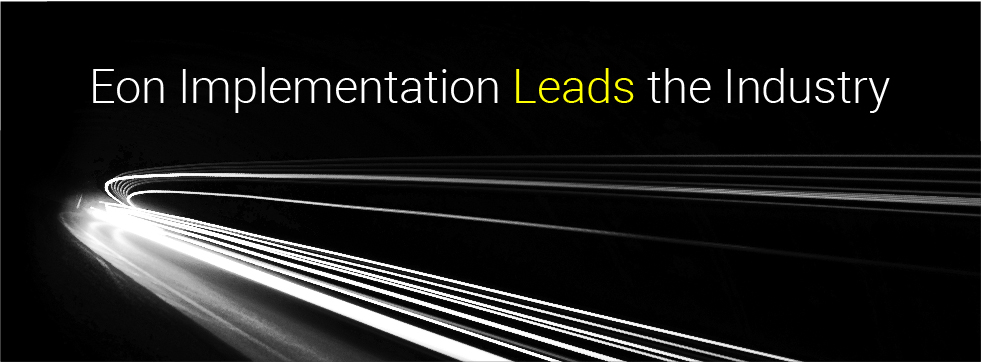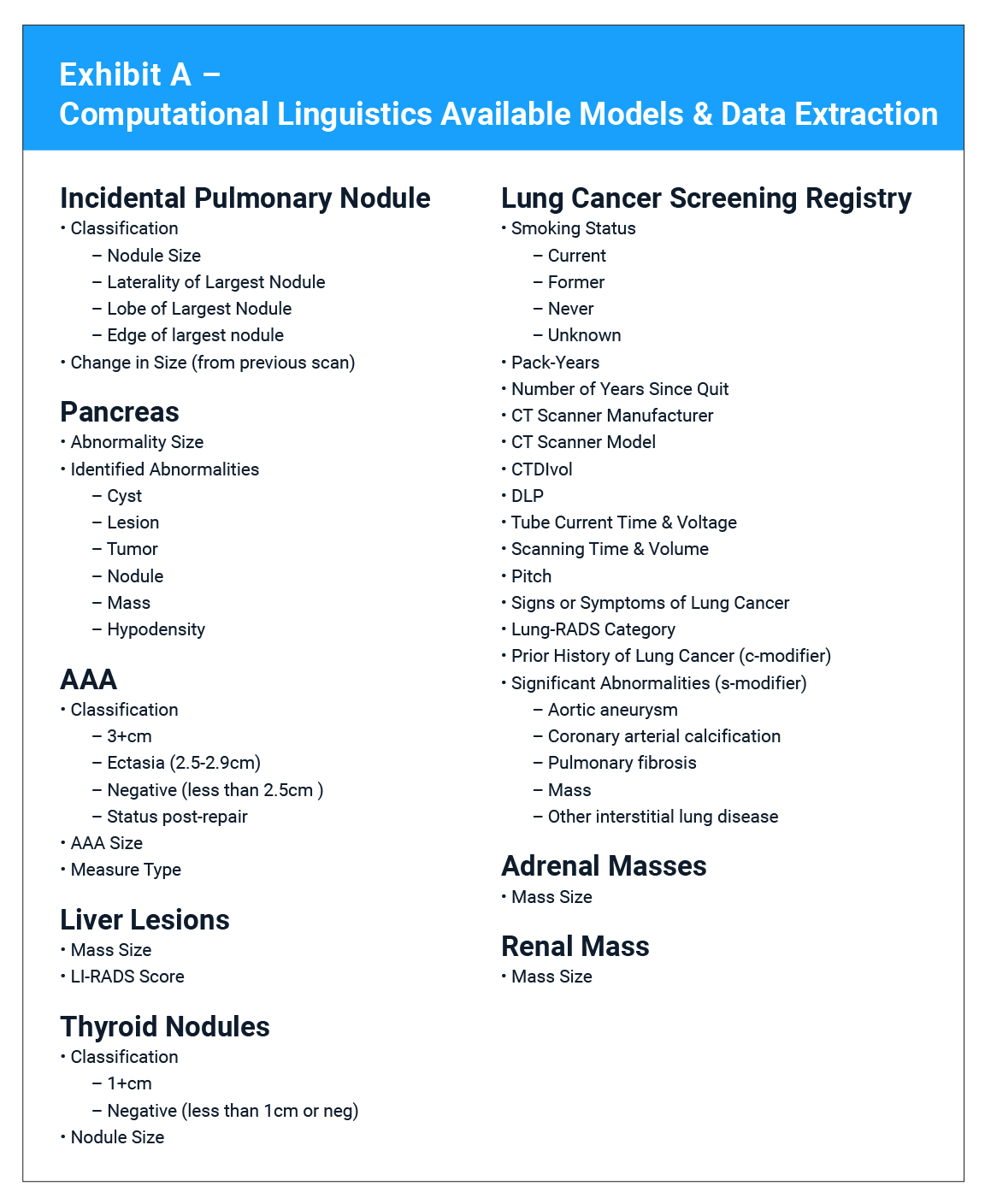It’s not Eon vs. Epic, it is Eon + Epic, and Eon pairs well with Epic to make Eon Patient Management seamless, efficient and effective. While Epic does some things really well, it does not have a focus on data science. So, when identification of patients based on free-text is needed, Eon excels. Eon also excels at imbedding guidelines and automation for longitudinally tracking patients, thereby ensuring no patient is overlooked or does not receive evidence-based care. Conversely, Epic relies on the radiologists appropriately flagging these patients. At Eon, data science is our lifeblood, and our mission is to make patients healthier and healthcare affordable.
Eon is a powerful supplement to Epic. Eon’s sophisticated implementation team works closely with your hospital’s IT group to build the most proficient EPM solution available. Depending on the scope of the project, the internal technical IT capabilities, and required clinical behavior, Eon can provide a customized solution that exceeds expectations. The Eon solution incorporates high precision linguistics and guideline based automation to streamline clinical workflow and achieve documented patient outcomes.
Here is why the Eon + Epic integration solution is vastly superior to an Epic-only build:
-
Identification of Abnormalities
Best in class Computational Linguistics (CL) that does not require radiologist workflow disruption or behavior modification Specifically, the Eon CL solution does not require use of macros or structured radiology reports to identify patients with abnormalities found on imaging. CL is a superior form of Natural Language Processing (NLP) because it is contextual (see Figure 1). Eon CL achieves a higher Positive Predictive Value (PPV) by understanding complex medical ontologies and identifies abnormalities with high precision and accuracy.
Epic-only solution requires radiologists to utilize Macros and Structured reports that are used as flags. These trigger phrases are required because Epic is not focused on data science and has not created data science models for this space. Because of this, an Epic-only solution is highly dependent on Radiologist Adherence, creating the potential for false negatives and patients slipping through the cracks.
Epic-only solution is labor-intensive because Epic creates a list of patients for manual Coordinator curation of actionable patients versus patients with previous or known findings.
Specifically,
- Computational Linguistics extracts pertinent data to inform the Coordinator about the finding so they can make quick decisions without looking in disparate systems to collate information. This data also helps to determine next steps for the patient’s care pathway, as defined below in #2. Please see Exhibit A for all CL Models and Data Extraction.
- Computational Linguistics also extracts Lung Cancer Screening Registry specific data from radiology free-text reports. Between this and supplemental EMR data, subsequent submission to the registry can be fully automated.
Figure 1: Computational Linguistics (CL) is a superior form of Natural Language Processing (NLP) because it is contextual. Contextual information integration is shown below.
-
Automation of Care Pathways
Eon is able to remove approximately 80% of the Coordinator’s repetitive tasks and manual tracking using advanced business logic. The logic is based on YOUR clinical requirements, not the care plan or guidelines we require. This logic automates and streamlines clinical workflow by 80%, allowing your resources to focus on the patients most at risk and who need immediate care coordination. EPM is not rigid and can customize care pathways based on how you treat patients. Epic does not utilize business logic to automate redundant tasks and requires manual efforts for data collation, expected next steps, and care pathway decisions.
Specifically,
- In EPM, patients are automatically triaged based on pertinent clinical information extracted from the CL models. Based on the collation of this information, patients are risk stratified, the clinically appropriate next steps (chosen and approved by you) are auto-populated and the patients are placed on the appropriate worklist.
- Low-risk patients have the expected next steps automatically entered. In addition, your requirements for provider and patient communication are automated including pre-populated letters, faxes and texts. These documents can be batch created and sent, as well as forwarded to Epic (level of integration will depend on routing configured by your IT team). In addition, any phone calls documented in Eon can be forwarded to Epic as phone encounters (again configuration by your IT team).
- High-risk and indeterminate patients can be sent directly to a Subject Matter Expert (SME) worklist for review and expected next step entry. Upon completion, the patient is sent back to the Coordinator for care coordination and communication to provider and patient.
-
Longitudinal Tracking
No more spreadsheets, no patients left behind. Eon’s cloud-based dashboard allows for multiple stakeholders to view patients at different times in the patients care pathway. Once Patient Identification and Care Pathway Automations have occurred, Eon ensures insight and oversight of patient processes — ensuring follow-up exams occur and guidelines are adhered to (as approved by you).While Epic is the main hub for ordering and scheduling, Epic does not create carepath-specific worklists and provide automated expected next steps for patient care. This means Epic cannot provide an overview of patient adherence. For example, Epic will not know when a carepath-specific event was supposed to be scheduled and wasn’t, and does not identify patients who were scheduled to receive a care pathway exam but did not show up for it.
Specifically,
- EPM knows exactly what event should happen next for every patient and when. EPM is constantly listening for that order to be scheduled and completed. If an order or scheduled exam does not occur, the Coordinator is notified to intervene. If an exam is scheduled, the Coordinator knows and does not require further action.
- If the patient misses a specific care pathway event, with Eon, the Coordinator will be notified and the patient auto-added to the Overdue Worklist.
- Patients move between worklists depending on their care plan and what is required next.
- Discrete Deactivation Reasons for Care Pathways ending are always captured in Eon, allowing for real-time program review and analysis.
-
Real Time Analytics
Eon offers powerful reporting and data analysis that does not require IT analyst data extraction or take weeks, or even months, to produce. All reporting is real time as well as date-range based.
- In-dash data export
- Canned reporting
- Custom reporting
-
Fast Implementation
Eon is able to implement within complex Hospital Networks quickly and efficiently. Epic sites can be some of Eon’s best integrations. While Eon can implement as fast as seven days, complex implementation requiring bi-directional feeds and multiple patient cohorts will require 12-16 weeks. Typically client IT timelines control the implementation process and determine time to completion. Eon always provides a Project Manager during the implementation and requires a minimal amount of Hospital Resources to achieve success. In contrast, when a facility decides to build a solution within Epic, an Epic build can require nine or more resources on multiple project calls for a minimum of six months and take up to 17 months before the project can be live. See the requirements for an internal Epic solution build:
Internal Epic Solution Build Requirements
- Staffing: Your system will need to staff at a minimum of 9 resources
- Project Lead
- Project Manager
- Clinical Informatics Specialist;
- Clinical Operations SMEs x2 minimum
- IT staff including Epic Clarity Analyst (reporting), Epic Clindoc analyst (Hospital & ED build), Epic Ambulatory analyst (Outpatient build);
- Quality Assurance staff;
- Training staff
- And, potentially other technical resources.
- Project Manager Time Allocation: A Project manager will take 2-3 months working with Informatics Specialist and Clinical SME’s to design the desired workflow before activating IT services.
- Project Prioritization: Build requirements as evaluated by IT staff for feasibility and scheduling
- Because this is typically an operational project – NOT CAPITAL – the IT staff will schedule the changes with other priorities and build may not start for at least 6 months…
- Clarity/Reporting Analysts: These will be needed to build an Epic Registry to identify patients, and Metrics to capture critical observations for clinical staff
- Typically > 6 month project for any new registry to make it to production in Epic. The majority of this time is building logic that Eon already has
- Epic Report analysts are paid ~$100k and will be required for post project maintenance
- Supporting Team: Additional Epic analysts will be required to configure workflows, this is a different skill set than the report analyst.
- Workflow build can happen in parallel, but will require the same change time frame > 6 months for release
- This requires a hospital build analyst and ambulatory analyst as the workflow will cross these areas
- Workflow will use patient workqueues (lists) to guide users in follow up requirements
- These are often exported from epic and addressed on spreadsheets.
- Once the build is done by Reporting and Application analysts, QA and Training can start.
- Additional changes may be needed after QA extending the timeline
- QA will take at a minimum one month, training another month
- Additionally this build must be evaluated with every Epic upgrade that happens, which is quarterly for most organizations.
Exhibit A – Computational Linguistics Available Models and Data Extraction
- Staffing: Your system will need to staff at a minimum of 9 resources





